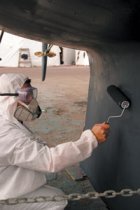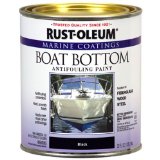Marine Antifouling
 By Tom stress
By Tom stress
In case your watercraft stays inside water about an element of the 12 months, great antifouling paint is critical for maintaining it carrying out its most readily useful, and for lowering fuel costs. Many boaters discover bottom artwork messy and tedious, but it’s one of the secret preventative upkeep tasks that keep your boat in form. A clear hull is safe, fast and efficient, and a fouled bottom cuts your top speed, problems maneuverability and reduces your fuel economic climate.
Antifouling paint keeps marine organisms, taking the kinds of shell (animal fouling from barnacles and zebra mussels), weed (plant development) and slime (single-celled algae) from connecting themselves to your motorboat. Most antifouling shows utilize the dissipation of material as a toxic biocide (on the hull’s surface plus in water) to avoid these nasty critters from adhering. Attaching copper below the waterline had been one of the first efficient strategies; the hulls of lumber sailing vessels from hundreds of years ago had been sheathed with solid copper. These days, boaters use underwater antifouling paint that is up to 70% copper, and cuprous oxide is the most well-known energetic bottom paint biocide.
Choosing an antifouling paint is local, as boaters into the Great Lakes, Pacific Coast, Southeast, Gulf Coast as well as other regions will select much like their particular neighbors inside regional marina. Your option also varies according to the method that you use your boat together with type of paint you used in past times (since there might be compatibility problems between some kinds yet others). Generally, gentler paints may be used over more difficult shows although not vice-versa. You can find exclusions however, so that it’s constantly best to consult a compatibility chart.
Are you currently painting over an aluminum hull or sterndrive?
Make use of paint with zinc or copper thiocyanate biocides. Bottom paints containing cuprous oxide can’t be utilized on aluminum because of galvanic action. Vivid, Trilux 33, with cuprous thiocyanate biocide, and zinc pyrithione-based Trilux 33 Aerosol and Alumaspray Plus are formulated to be used on aluminum. Main-stream paints will destroy an aluminum hull in short order.
Would you like brilliant colors?
Use paint with copper thiocyanate, zinc or ECONEA biocide. White copper (cuprous thiocyanate) is clean white in shade and utilized in Pettit’s Vivid and Interlux Trilux 33. It entails 50per cent less content compared to the hefty, dark copper utilized in standard antifouling paint. Produces the brightest colors, whitest whites and blackest blacks. Additionally, unlike many metal-based antifouling agents, ECONEA may be used to effortlessly formulate light and brilliant shows, resulting in brilliant colors with better persistence. ECONEA will not cause stain in the existence of sulfides, because do metal-based paints.
Are you currently in a place that limits copper biocides?
Utilize a paint with zinc or ECONEA biocides.
Non-biocide paints—foul release coatings: Biocide-free nasty release coatings are simply just starting to be available to leisure boaters, used on propellers in items like the most popular PropSpeed. They’re like super-ablative shows, but with no copper biocide. These super-slick shows, particularly Intersleek 900, work very well on the hulls of quick commercial vessels that get made use of each and every day, but they’re finicky to make use of, calling for specialized application by specially-trained painters.
Have you been in a location where slime is difficulty?
Make use of paint with a slime-reducing additive like Biolux®, or zinc pyrithione, also referred to as zinc omadine. These ingredients block photosynthesis close to the water’s surface and limit the rise of algae.
Do you want to haul on across cold temperatures and relaunch without repainting?
Use copolymer ablative kind paint. Copolymer paints release biocide at a continuing controlled rate in their resides, putting on away or “ablating” just like a bar of soap. Paint wears off quicker in greater drag places on hull and appendages. These shows work well in high-growth places and carry on being effective after haulout after the summer season. Into the spring, the paint is reactivated with a scrubbing or light sanding and you’re ready for the next period. This can be a massive time-saver for the people living in northern climates. As the portion of copper inside paint is essential for evaluating its effectiveness, copper content isn't the only consideration. Controlled polishing, the technology that manages exactly how quickly the paint wears away, is yet another method we measure the effectiveness in a copolymer ablative paint.
We advice a covering of 2 or 3 coats regarding very first application. Copolymer paints with anti-slime additives would be best for hefty fouling areas. Environmentally better: CFA Eco, Ultima ECO and Pacifica Plus are ECONEA-based copolymer ablatives.
Ablative paints (regarding the non-polymer type) operate in a similar way and minimize the annual ritual of sanding whenever applying a new coating. Best use is as a single-season paint for ships that are utilized often, but they are not serviced by a diver. Not recommended when you wish a super-smooth base finish and also a diver safeguard it, since scrubbing removes paint and decreases longevity.
Will you be using a vinyl-based paint?
Make certain you get rid of the old paint film unless it’s additionally vinyl based.
Are you currently in saltwater or freshwater?
There are particular shows which can be suitable for freshwater, many shows which are particularly suggested against freshwater use.
Can you make use of your motorboat frequently or infrequently?
Frequently used boats may choose to use an ablative paint, that may get smoother over some time will drop light growth. Infrequently used ships might want to use a modified epoxy paint that'll have great antifouling properties whenever boat is inactive.
You might also like

|
Rust-Oleum 207012 Marine Flat Boat Bottom Antifouling Paint, 1-Quart, Black Home Improvement (Rust-Oleum)
|





